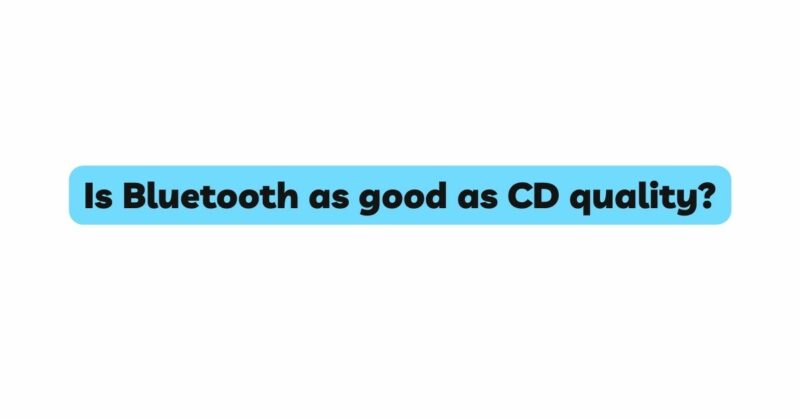In the realm of audio fidelity, the dichotomy between traditional CD quality and the contemporary allure of Bluetooth audio has sparked a spirited debate. Both technologies have established their dominion over the way we experience music, with their own unique attributes and inherent limitations. In this exploration, we dissect the intricacies of audio quality, unraveling the nuances that distinguish Bluetooth from CD quality and investigating whether Bluetooth audio truly rivals the sonic prowess of CDs.
The Evolution of Sound Reproduction
Compact Discs (CDs) were a groundbreaking innovation when they emerged in the 1980s. Armed with the capacity to store uncompressed, high-resolution audio, CDs quickly supplanted the analog predecessors, delivering unprecedented sound clarity and fidelity. The digital audio encoded onto CDs is based on Pulse Code Modulation (PCM), a method that captures audio as a sequence of numerical samples. This process effectively preserves the intricate details and dynamics of the original recording.
Bluetooth technology, on the other hand, is a product of the wireless age. Initially introduced as a means of connecting peripherals, Bluetooth’s prowess has expanded to encompass audio transmission. The most common codecs for Bluetooth audio are Advanced Audio Codec (AAC) and Subband Coding (SBC), which employ data compression techniques to transmit audio wirelessly. However, Bluetooth has evolved with higher-quality codecs like Qualcomm’s aptX, aptX HD, and Sony’s LDAC, promising near-lossless audio transmission.
Understanding Compression and Bitrate
The crucial factor that distinguishes CD quality from Bluetooth audio lies in compression and bitrate. Bitrate refers to the amount of data processed per unit of time, often measured in kilobits per second (kbps). In CD-quality audio, the bitrate is fixed at 1,411 kbps, representing the original audio source’s full spectrum. This results in unparalleled sonic fidelity that remains faithful to the artist’s intention.
Bluetooth audio, due to the constraints of wireless transmission, employs data compression to reduce the size of audio files. While lossless codecs like aptX HD and LDAC aim to minimize audio data loss, earlier codecs like SBC and even AAC may sacrifice some audio information for the sake of efficient wireless transmission. This compression can lead to a perceptible reduction in audio quality, especially when compared to the pristine sound offered by CDs.
The Audiophile Perspective
For audiophiles and dedicated music enthusiasts, the quest for uncompromised audio quality is an integral part of their musical journey. To this discerning audience, the discrepancies between CD quality and Bluetooth audio can be both subtle and profound. Audiophiles often prioritize sonic authenticity and transparency, seeking to recreate the artist’s original vision with utmost accuracy. In this pursuit, the nuanced details, dynamic range, and subtleties inherent in CD-quality audio hold a distinct allure.
In contrast, Bluetooth audio caters to the modern lifestyle, emphasizing convenience and accessibility. The ability to stream music wirelessly from smartphones, tablets, and laptops epitomizes the freedom of choice and the practicality of our digital age. While discerning listeners might detect differences between CD quality and Bluetooth audio, the convenience and versatility of Bluetooth audio often outweigh these perceived disparities.
Context Matters: The Listening Environment
An important facet of the CD quality vs. Bluetooth audio debate is the context in which the audio is experienced. In controlled listening environments, with high-quality headphones or audio systems, the differences in audio quality might be more pronounced. However, in real-world scenarios such as casual listening on portable Bluetooth speakers or car audio systems, external factors such as ambient noise, acoustic limitations, and varying levels of audio gear quality come into play.
The Car Audio Conundrum
The car audio environment introduces a unique challenge to the CD quality vs. Bluetooth audio discourse. While some modern vehicles boast advanced audio systems that rival home setups, others are equipped with more modest sound systems. Road noise, engine vibrations, and cabin acoustics add layers of complexity to the listening experience, potentially diluting the perceived differences between CD quality and Bluetooth audio.
Furthermore, the convenience factor looms large in the car audio equation. Bluetooth connectivity allows drivers and passengers to effortlessly switch between songs, playlists, and audio sources, all while keeping their focus on the road. This level of integration and hands-free convenience has become a defining feature of modern in-car entertainment systems.
The Verdict: Balancing Quality and Convenience
In the grand tapestry of audio quality, the question of whether Bluetooth audio is as good as CD quality is a multifaceted puzzle. While CD-quality audio undeniably possesses an edge in delivering unadulterated sonic brilliance, Bluetooth audio has made remarkable strides in narrowing the gap. High-quality codecs like aptX HD and LDAC have significantly improved wireless audio transmission, resulting in audio that can be remarkably close to CD quality, especially to the average listener.
Ultimately, the choice between CD quality and Bluetooth audio hinges on personal priorities. Audiophiles and purists might continue to vouch for the unparalleled richness of CD-quality audio. On the other hand, the modern listener, often navigating a fast-paced, wireless world, finds solace in the convenience of Bluetooth audio without a substantial sacrifice in audio quality.
As technology evolves, the boundaries between CD quality and Bluetooth audio continue to blur. Audio manufacturers are constantly innovating to provide seamless, high-fidelity wireless audio experiences. Whether you prioritize the nostalgia of physical media or the wireless flexibility of Bluetooth, both options cater to a diverse range of preferences and lifestyle choices. The journey of sound quality remains a dynamic and ever-evolving adventure, promising an auditory experience that resonates with each individual listener.


